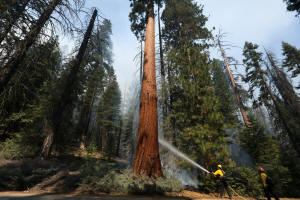Giant sequoias survived a California wildfire. Next time, they may not
be so lucky
 Send a link to a friend
Send a link to a friend
 [August 03, 2022]
By Travis Hartman, Ally Levine and Anurag Rao [August 03, 2022]
By Travis Hartman, Ally Levine and Anurag Rao
(Reuters) - For millennia, giant sequoias –
the largest trees on Earth – have resisted and relied on fire. But
today's wildfires are far more frequent and intense due to
climate-fueled droughts.
In July, the Mariposa Grove of giant sequoia trees in Yosemite narrowly
avoided disaster in the Washburn Fire due to quick action and long-term
planning.
Here are some ways sequoias co-exist with fire and how humans are
protecting them from the increased threats they face:
FIGHTING FIRE WITH FIRE
Drought across the western United States and high winds, amplified by
the slow creep of climate change, are only two of the many factors
contributing to why wildfires have grown in severity over the last few
decades.
Fire prevention tactics from 1870 to 1970 created an excess of fuel
material on the forest floor that would have otherwise been consumed by
the natural wildfire cycle. Combined with years of drought, the forests
are now extremely susceptible to lightning or a careless human starting
a blaze.

Over the last half century, fire experts at Yosemite have attempted to
mitigate wildfire spread and intensity by deliberately setting smaller
fires, a technique called a prescribed burn that was used by the
indigenous populations in the area before settlers and fire suppression
arrived.
“Having to protect sequoias from fire is a very new phenomena, so we’re
trying things out,” said Garrett Dickman, a biologist with Yosemite
National Park. “And really the thing that seems to work is prescribed
fire.”
ANCIENT GROVES
Located in the southern portion of Yosemite National Park, the Mariposa
Grove is home to over 500 mature giant sequoias. It is the largest group
of sequoias in the park, with many trees over 2,000 years old.
“Mariposa Grove is one of only about 75 giant sequoia groves on the west
slope of the Sierra Nevada, and it’s one of the most important,” said
Athena Demetry, a restoration ecologist at Yosemite National Park. “It’s
where the national park idea was born.”
This grove, along with Yosemite Valley, were among the first lands to
become national parks when President Abraham Lincoln signed legislation
protecting the country’s natural beauty and resources.
[to top of second column]
|

A sequoia is sprayed as the Windy Fire burns amid sequoias in
Sequoia National Forest near California Hot Springs, California,
U.S., September 21, 2021 .REUTERS/David Swanson

URGENT ACTION NEEDED
Another potential threat to the sequoias, the Oak Fire ignited just
10 miles (16 km) from Yosemite about two weeks after the Washburn
Fire, destroying more than 190 structures and prompting thousands of
evacuations. The Oak Fire has been largely corralled but further
highlights the wildfire danger in the area.
In just six years, between 2015 and 2021, more than 85% of giant
sequoia groves burned in wildfires, compared with 25% in the 100
years prior, according to the National Park Service. The United
States Forest Service has responded to the threat, declaring they
will strive to reduce severe wildfire likelihood in 12 of the 37
groves under their jurisdiction.
“Without urgent action, wildfires could eliminate countless more
iconic giant sequoias,” said Forest Service Chief Randy Moore in a
statement released by the U.S. Department of Agriculture’s Forest
Service.
Teams of Forest Service employees, firefighters and contractors will
reduce surface and ladder fuels, remove small trees and conduct
prescribed burns on approximately 13,000 acres where fire experts
have determined the giant sequoias are most susceptible. Efforts
beginning this month are expected to conclude in November 2023.
“This emergency action to reduce fuels before a wildfire occurs will
protect unburned giant sequoia groves from the risks of
high-severity wildfires,” said Moore.
This tactic proved effective in the case of the Washburn Fire where
prescribed fires and ground clearing in Mariposa Grove sent the fire
around instead of through the grove of ancient trees.

“It’s such a sacred ground, and protecting those trees is so
important to us,” said Sarah Platt, a spokesperson and wildland
firefighter for Yosemite National Park.
“Giant sequoias are the root of Yosemite National Park.”
(Reporting by Travis Hartman and Ally Levine in New York;
Illustrations by Anurag Rao in Bangalore; Editing by Fielding Cage
and Lisa Shumaker)
[© 2022 Thomson Reuters. All rights
reserved.]
This material may not be published,
broadcast, rewritten or redistributed.
Thompson Reuters is solely responsible for this content. |